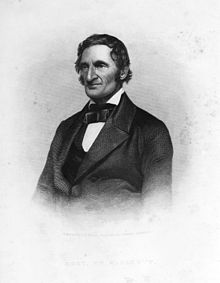William A. Alcott
| William Andrus Alcott | |
|---|---|
 |
|
| Born |
August 6, 1798 Wolcott, Connecticut |
| Died | March 29, 1859 (aged 60) Auburndale, Massachusetts |
| Nationality | American |
| Occupation | educator, physician, author |
William Andrus Alcott (August 6, 1798 – March 29, 1859), also known as William Alexander Alcott, was an American educator, educational reformer, physician, and author of 108 books. His works, which include a wide range of topics including educational reform, physical education, school house design, family life, and diet, are still widely cited today.
William Alcott was born in Wolcott, Connecticut. His father was a farmer, Obedience Alcott (1776–1847); in the 1820s, like many members of the family, he altered the spelling of his last name, which on his tombstone appears as "Obid. Alcott". His mother was Anna Andrus (1777–1864) who was the daughter of a Revolutionary War soldier and William's most important educational influence. He attended local schools and became a close friend with his near neighbor Amos Bronson Alcott who would later enjoy wide fame as a philosopher and as the father of writer Louisa May Alcott. Although sometimes described simply as "cousins" the two were actually second cousins; William's grandfather David Alcott (1740–1841) was the brother of Amos Bronson Alcott's grandfather, Captain John Alcott. The two boys shared books, exchanged ideas, and started a small library together. Odell Shepard had written of Amos Bronson Alcott, "Indeed there is a sense in which nearly everything Alcott wrote and did is attributable to William"
At the age of 18 Alcott began teaching in a school located just a few yards from his father's house. With brief interruptions, he would continue to teach for the next nine years. His experiences as a student country school teacher would later become the subject of many of his later publications. He observed that the benches used by students were often painful and, at his own expense built backs onto the benches; these became the ancestors of the later school desks. He campaigned for better heating and ventilation in schools. He labored to improve the intellectual content of classrooms. While he was successful as a teacher, in the summer of 1824 he suffered an attack of the disfiguring, dangerous skin infection erysipelas, and about this time was beginning to suffer from tuberculosis. He would suffer symptoms of both for the remainder of his life. He began studying medicine, with the thought that the extra knowledge would aid his teaching. His formal study of medicine was brief. In the winter of 1825–26 he attended "a regular course of medical studies" in New Haven, Connecticut. In March 1826 he was granted a license to practice medicine. In addition to teaching, he practiced medicine at least until 1829.
...
Wikipedia
